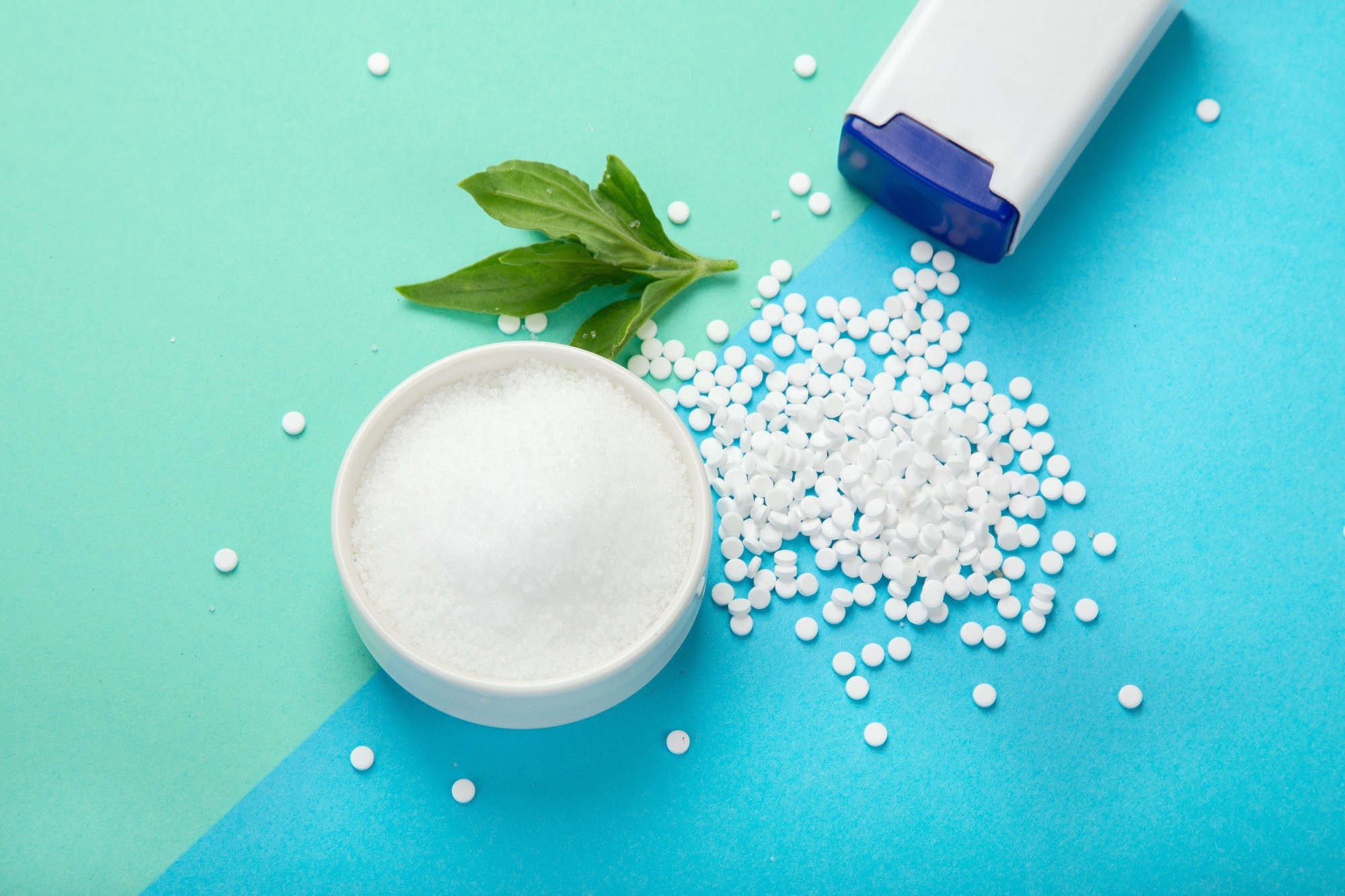In a recent study published in Nutrients, researchers compared the effects of four types of sweeteners on insulin sensitivity in young adults in a two-week clinical trial.
Their findings indicate that effects vary according to the sweetener type, with fructose particularly detrimental to hepatic insulin sensitivity and glucose having the strongest effect on muscle insulin sensitivity.
Study: Effects of Consuming Beverages Sweetened with Fructose, Glucose, High-Fructose Corn Syrup, Sucrose, or Aspartame on OGTT-Derived Indices of Insulin Sensitivity in Young Adults. Image Credit: Tatjana Baibakova/Shutterstock.com
Background
Estimates suggest that more than 500 million people (10%) in the world have diabetes and that type 2 diabetes (T2DM) accounts for more than 90% of these cases.
Insulin resistance and insulin sensitivity are key characteristics of T2DM and can be measured through indices calculated using oral glucose tolerance tests (OGTT). These indices include Matsuda Insulin Sensitivity Index (ISI), Surrogate Hepatic Insulin Resistance Index (IRI), Stumvoll Index, and Predicted M ISI.
Sugar-sweetened beverages (SSB) increase the risk of weight gain and developing T2DM, and observational studies have found strong correlations between SSB consumption and insulin resistance.
However, inconsistent results for many sensitivity indices highlight the need for robust study protocols that factor in varying doses and types of sugars and which indices are used to measure sensitivity.
About the study
The present double-blinded, parallel-arm, dietary intervention study was part of a five-year investigation and compared the effect of major sugars – such as sucrose (n = 24), high-fructose corn syrup (HFCS) (n = 28), glucose (n = 28), and fructose (n = 28) – on insulin sensitivity indices from young adults. Aspartame served as the control beverage (n = 23).
Participants were included if they had a stable self-reported body weight over the preceding six months and a body mass index between 18 and 35 kg/m2. Exclusion criteria included high levels of fasting triglyceride, fasting glucose, and blood pressure.
Individuals who smoked, had surgery for weight loss, consumed high levels of SSB or alcohol, used certain medications, and exercised more than 3.5 hours a day were also excluded.
Before the study, participants avoided sugary beverages for five weeks. Groups were matched based on sex, body mass index (BMI), and fasting serum concentration (triglyceride, cholesterol, and insulin).
A 3.5-day baseline period was followed by 12.5 days of assigned beverage consumption while maintaining everyday habits.
During the final 3.5 days of the study, participants continued their dietary interventions at the study center and participated in experimental procedures.
On days four and 20, OGTT was conducted, and plasma and glucose samples were taken. Surrogate Hepatic IRI, Matsuda ISI, Predicted M ISI, and Stumvoll Index were calculated from the OGTT.
Absolute change between the baseline and two weeks after the intervention was examined. Two-factor general linear models and analysis of covariance were used to analyze the data.
Findings
The final study included 131 participants, with no significant differences in metabolic or anthropomorphic parameters across the experimental groups at baseline. The type of SSB consumed did not significantly affect changes in body weight.
Participants who consumed the fructose SSB showed significantly higher levels of Surrogate Hepatic IRI than the control group who consumed aspartame SSB.
Static indices such as fasting insulin were not significantly different between the intervention group. Male participants showed higher increases in fasting glucose after two weeks than females.
OGTT glucose levels were significantly higher for participants assigned HFCS or glucose compared to the control group. OGTT insulin was also more elevated for glucose, HFCS, and sucrose consumers.
Matsuda ISI was lower in the groups that consumed fructose, HFCS, and sucrose than those that consumed aspartame. However, changes in predicted M ISI were statistically similar across the groups.
Both glucose and fructose contributed to OGTT-derived indices. Fructose alone contributed to fasting glucose and an increase in hepatic IRI.
Glucose had a higher effect than fructose on glucose level increases and OGTT insulin and was observed to decrease Stumvoll ISI. The effect of fructose was also stronger for Matsuda ISI, while glucose contributed more to decreases in Predicted M ISI.
Overall, the study results agree with previous intervention trial findings showing that fructose-SSB caused a higher decrease in hepatic insulin sensitivity than complex carbohydrates and glucose-SB.
Conclusions
The findings of this study indicate that fructose SSBs negatively affected those outcomes that measure hepatic insulin sensitivity, while glucose SSBs did not.
While glucose SSBs and fructose SSBs had detrimental effects on muscle insulin sensitivity, the effect of glucose was greater.
The authors concluded that different types of sweeteners have varied effects on insulin resistance and sensitivity, which could explain the heterogeneity observed in previous studies.
The study followed robust standardization protocols and successfully eliminated physical activity and diet variations.
Researchers also measured compliance with the dietary intervention by introducing riboflavin into the SSBs, measured in urine samples. However, interventions were not randomized, which could result in assignment bias.
Another limitation was that the intervention took place for only two weeks. The authors acknowledged that these promising findings should be validated and confirmed through longer-term studies that include more diverse participants.
Journal reference:
-
Hieronimus, B., Medici, V., Lee, V., Nunez, M.V., Sigala, D.M., Bremer, A.A., Cox, C.L., Keim, N.L., Schwarz, J., Pacini, G., Tura, A., Havel, P.J., Stanhope, K. (2024) Effects of consuming beverages sweetened with fructose, glucose, high-fructose corn syrup, sucrose, or aspartame on OGTT-derived indices of insulin sensitivity in young adults. Nutrients. doi:https://doi.org/10.3390/nu16010151. https://www.mdpi.com/2072-6643/16/1/151
